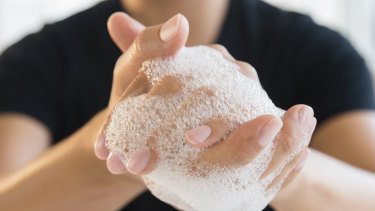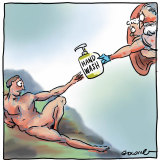Hand sanitiser or soap: What’s better to protect against coronavirus?
Coronavirus panic has caused a spike in demand for hand sanitiser, with supplies running low in supermarkets and chemists around the world.
The World Health Organisation has advised the public that they can help to protect themselves and others from the outbreak by frequently washing their hands. But is plain soap or hand sanitiser more effective?
Plain old soap and water will “do the trick”.Credit:Getty
Professor Mary-Louise McLaws, an infection control expert from UNSW, says hand sanitisers are important for hospital staff to protect against the spread of germs and viruses among vulnerable patients.
The rest of us should opt for plain soap and water where possible.
Illustration: Matt GoldingCredit:
“The whole idea of hand hygiene is to remove, not to kill, the germs we have,” McLaws says.
Hand sanitisers are not the first port of call for several key reasons.
Firstly, because about 300,000 bacteria reside on our hands at any one time, but most help to keep the outer dermal layer of our skin healthy.
Secondly, because the ingredients in hand sanitisers don’t penetrate organic protein, McLaws explains, so they won’t work to remove dirt, stickiness, harmful chemicals, urine or fecal matter from our hands, while soap and water will.
Lastly, research has found soap and water are more effective than hand sanitisers at removing certain kinds of germs.
“You don’t use it instead of a soap-and-water wash after going to the bathroom,” she says. “But, if you can’t get a soap-and-water wash when you’re out in the community then an alcohol-based hand rub is a great alternative.”
How safe are hand sanitisers to use?
One Australian study from 2018 suggested some bacteria were becoming “increasingly tolerant” to alcohol-based hand sanitisers.
“The World Health Organisation didn’t support the findings,” McLaws says of the study. “There are multiple potential reasons for the findings and they haven’t been repeated.”
In terms of the ingredients used in hand sanitisers, McLaws says the current ingredients have been “deemed to be safe”.
“The CDC (Centre for Disease Control) was very careful to make sure healthcare workers were kept safe given their high exposure,” she explains, adding nurses use hand sanitisers, on average, 20 times every shift. For this reason, in 2017, they removed a “potential risk” ingredient (triclosan) which can interfere with the body's hormonal systems.
The original ingredients in hand sanitisers were also not “terribly kind to the skin”, McLaws says and, to remedy this, they have changed over time and now typically contain emollients, which protect the skin.
A WHO review into skin reactions related to hand hygiene products found no product, including plain soap, “is free of potential risk”, however, they said alcohol-based hand rubs typically do not dry out the dermal layer or cause irritation.
The exception is if you have already washed your hands with soap and water.
“Some analyses found the soap-and-water wash opens the cells on your skin and made it more permeable to the alcohol which then dried and cracked the skin, so do not do both,” McLaws says.
She adds that children have more sensitive skin and should also use soap and water over sanitiser where possible.
Is chemical sanitiser better than natural sanitiser?
“I understand why people like them, but I haven’t seen the science that says the natural sanitiser has the same kill level as the active ingredients,” McLaws says.
To be effective, the US FDA recommends using sanitisers that contain 60 to 90 per cent isopropyl alcohol, whether it is a “natural” sanitiser or not.
“Often alcohol-based hand rubs contain a mix of both [ethyl and isopropyl alcohol],” McLaws explains. “Ethanol is a good antiviral while isopropyls are good antibacterials. Together, they are synergistic. Either must now be above 60 per cent.”
Regardless, we are still better off sticking with soap and water where possible.
How to wash your hands properly
“A hand soap wash will do the trick and people do not need a medicated soap,” McLaws advises.
“Lather it up and do between fingers, around the nail bed and under your nails and on the back of your hands and rinse it off. That should take about 20 seconds if you do it properly, not five seconds.”
Source: Read Full Article





